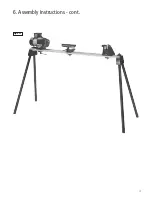
6
13. Store machines safely when not in use
• When not in use, machines should be stored in a dry place, out of reach
of children. Do not allow persons unfamiliar with these instructions or
with the machine to operate it.
14. Do not overreach
• Choose a working position that allows your body to remain balanced
and feed the work piece in to the machine without overreaching.
• Keep proper footing and balance at all times.
15. Electrical supply
• Electrical circuits should be dedicated to each machine or large enough
to handle combined motor amp loads. Power outlets should be located
near each machine so that power or extension cables are not obstructing
high-traffic areas. Observe local electrical guidelines for proper
installation of new lighting, power outlets, or circuits.
• The machine must be connected to an earthed power supply.
• The power supply must be equipped with a circuit breaker that provides
short circuit, overload and earth leakage protection.
• The voltage of the machine must correspond to the voltage of the mains
power supply.
• The mains plug fitted to the machine should always match the power
outlet. Do not modify the plug in any way. If a replacement plug is
required it should be fitted by a competent person and of the correct
type and rating for the machine.
• If you are unsure about any electrical connections always consult a
qualified electrician.
16. Avoid unintentional starting of the machine
• Most machines are fitted with a no-volt release (NVR) switch to prevent
unintentional starting. If in doubt always ensure the machine switch
is in the ‘OFF’ position before connecting it to the power supply. This
means the machine will not automatically start up after a power cut or
switching on of the power supply, unless you first reset the start switch.
17. Outdoor use
• Your machine should not be used outdoors.
18. Extension cables
• Whenever possible, the use of extension cables is not recommended.
If the use of an extension cable is unavoidable, then it should have a
minimum core cross section of 2.5mm² and limited to a maximum length
of 3 metres.
• Extension cables should be routed away from the direct working area to
prevent a trip hazard.
19. Guard against electric shock
• Avoid body contact with earthed or grounded surfaces such as pipes
and radiators. There is an increased risk of electric shock if your body is
earthed or grounded.
20. Always work within the machine’s intended capacities
• Operator safety and machine performance are seriously adversely
affected if attempts to make the machine perform beyond its limits
are made.
21. Do not abuse the power cable
• Never pull the power cable to disconnect it from the power socket.
Always use the plug.
• Keep the power cable away from heat, oil and sharp edges.
• Do not use the power cable for carrying or moving the machine.
22. Secure the work piece
• Ensure that the work piece is securely held before starting to machine it.
• When working within 300mm of the machining area, always use a push
stick to feed the work piece in to the blade or cutting tool. The push stick
should have a minimum length of 400mm. If the push stick becomes
damaged, replace it immediately.
• Use extra supports (roller support stands etc.) for any work pieces large
enough to tip when not held down to the table top.
• Do not use another person as a substitute for a table extension, or as
additional support for a work piece that is longer or wider than the basic
table, or to help feed, support, or pull the work piece.
• Do not attempt to machine more than one work piece at a time.
• When feeding the work piece towards the blade or cutting tool never
position your hands in direct line of the cutting path. Avoid awkward
operations and hand positions where a sudden slip could cause your
hand or fingers to move into the machining area.
23. Stay alert
• Safety is a combination of operator common sense and alertness at all
times when the machine is being used.
• Use all machines with extreme care and do not use the machine when
you are tired or under the influence of drugs, alcohol or medication.
24. Use the correct tool for the job
• Do not use the machine for any purpose other than which it
was designed.
• When selecting replacement cutting tools and blades, always ensure that
they are designed to cut the material that you intend to use them for. If
in any doubt seek further advice from the manufacturer.
25. Connect dust extraction equipment
• Always use dust extraction equipment. The dust extractor should be of
suitable size and capacity for the machine that it is connected to and
have a filtration level appropriate to the type of waste being collected.
Refer to the relevant section of the manual for details of the specific dust
extraction requirements for this machine.
• The dust extractor should be switched ‘ON’ before starting the machine
that it is connected to. The dust extractor should be left running for 30
seconds after the last machining operation is complete in order to clear
any residual waste from the machine.
26. Ensure that the machine is correctly guarded
• Never use the machine if any of the standard safety guards and
equipment are removed or damaged.
• Some machines incorporate safety interlocks to prevent the machine
from being used without the guards in place. Never attempt to bypass
or modify the interlocks to allow the machine to be used without the
guards in place.
27. Maintain your machine with care
• This manual gives clear instructions on installation, set up and
operation of the machine and also details any routine and preventative
maintenance that should be performed periodically by the user.
• Remember always to switch off and unplug the machine from the power
supply before carrying out any setting up or maintenance operations.
• Follow any instructions for the maintenance of accessories
and consumables.
• Do not use compressed air to clean the machine. Always use a brush to
dislodge dust in places that are awkward to reach and a dust extractor
to collect the waste.
• Inspect electric cables periodically and, if damaged, have them replaced
by an authorised service facility or qualified electrician.
• Inspect extension cables (if used) periodically and replace if damaged.
28. Keep cutting tools sharp and clean
• Correctly maintained cutting tools are easier to control and less likely
to bind.
• Cutting tools and blades can become hot during use. Take extreme care
when handling them and always allow them to cool before changing,
adjusting or sharpening them.
2. General Health & Safety Guidance - cont.
























